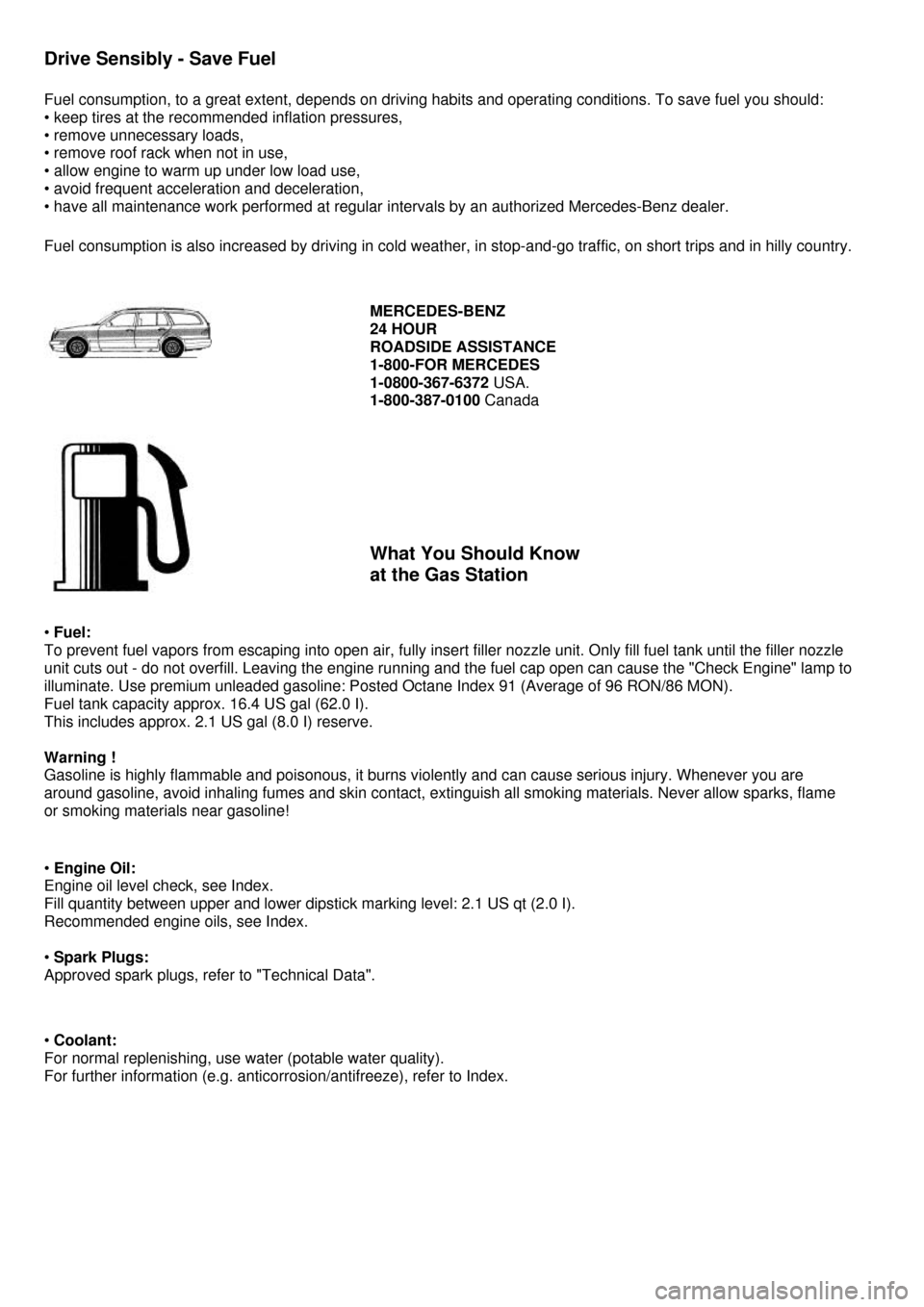Page 1 of 130

Drive Sensibly - Save Fuel
Fuel consumption, to a great extent, depends on driving habits and operating conditions. To save fuel you should:
• keep tires at the recommended inflation pressures,
• remove unnecessary loads,
• remove roof rack when not in use,
• allow engine to warm up under low load use,
• avoid frequent acceleration and deceleration,
• have all maintenance work performed at regular intervals by an authorized Mercedes-Benz dealer.
Fuel consumption is also increased by driving in cold weather, in stop-and-go traffic, on short trips and in hilly country.
MERCEDES-BENZ
24 HOUR
ROADSIDE ASSISTANCE
1-800-FOR MERCEDES
1-0800-367-6372 USA.
1-800-387-0100 Canada
What You Should Know
at the Gas Station
• Fuel:
To prevent fuel vapors from escaping into open air, fully insert filler nozzle unit. Only fill fuel tank until the filler nozzle
unit cuts out - do not overfill. Leaving the engine running and the fuel cap open can cause the "Check Engine" lamp to
illuminate. Use premium unleaded gasoline: Posted Octane Index 91 (Average of 96 RON/86 MON).
Fuel tank capacity approx. 16.4 US gal (62.0 I).
This includes approx. 2.1 US gal (8.0 I) reserve.
Warning !
Gasoline is highly flammable and poisonous, it burns violently and can cause serious injury. Whenever you are
around gasoline, avoid inhaling fumes and skin contact, extinguish all smoking materials. Never allow sparks, flame
or smoking materials near gasoline!
• Engine Oil:
Engine oil level check, see Index.
Fill quantity between upper and lower dipstick marking level: 2.1 US qt (2.0 I).
Recommended engine oils, see Index.
• Spark Plugs:
Approved spark plugs, refer to "Technical Data".
• Coolant:
For normal replenishing, use water (potable water quality).
For further information (e.g. anticorrosion/antifreeze), refer to Index.
Page 8 of 130

Driving Instructions
Warning !
If you feel a sudden significant vibration or ride disturbance, or you suspect that possible damage
to your vehicle has occurred, you should turn on the hazard flashers, carefully slow down, and drive with
caution to an area which is a safe distance from the roadway.
Inspect the tires and under the vehicle for possible da mage. If the vehicle or tires appear unsafe, have
it towed to the nearest Mercedes-Benz or tire dealer for repairs.
Power Assistance
Warning !
When the engine is not running, the brake and steering systems are without power assistance.
Under these circumstances, a much greater effo rt is necessary to stop or steer the vehicle.
Brakes
Warning !
After driving in heavy rain for some time without applying the brakes or through water deep enough to
wet brake components, the first braking action may be somewhat reduced and increased pedal
pressure may be necessary. Be sure to maintain a safe distance from vehicles in front.
Resting your foot on the brake pedal will cause excessive and premature wear of the brake pads.
It can also result in the brakes overheating th ereby significantly reducing their effectiveness.
It may not be possible to stop the car in sufficient time to avoid an accident.
The condition of the parking brake system is checked each time the vehicle is in the shop for the required service .
If the parking brake is released and the brake warning lamp in the instrument cluster stays on, the brake fluid level in
the reservoir is too low. Brake pad wear or a leak in the system may be the reason for low brake fluid in the reservoir.
Have the brake system inspected at an aut horized Mercedes-Benz dealer immediately.
All checks and maintenance work on the brake system s hould be carried out by an authorized Mercedes-Benz dealer.
Install only brake pads and brake fluid recommended by Mercedes-Benz.
Warning !
If other than recommended brake pads are installed, or other than recommended brake fluid is used, the
braking properties of the vehicle can be degraded to an extent that safe braking is substantially impaired.
This could result in an accident.
Caution !
When driving down long and steep grades, relieve the load on the brakes by shifting into a lower gear. This helps prevent
overheating of the brakes and reduces brak e pad wear. After hard braking, it is advisable to drive on for some time, rather
than
immediately parking, so the air stream will cool down the brakes faster.
Page 85 of 130

Hood
To open:
To unlock the hood, pull release lever (1) under the driver's side of the instrument panel. At the same time handle
(2) will extend out of the radiator grill (it may be necessary to lift the hood up slightly).
Caution !
To avoid damage to the windshield wiper or hood, open the hood only with wiper in the parked position. Pull handle
(2) completely out of radiator grill and open hood (do not pull up on handle).
To close:
Lower hood and let it drop into lock from a height of approx. 1 ft. (30 cm), assisting with hands placed flat on edges
of hood (3). To avoid hood damage, if hood is not fully closed, repeat closing procedure. Do not push down on hood
to attempt to fully close it.
Warning!
To help prevent personal injury, stay clear of moving parts when the hood is open and the engine is running.
Be sure the hood is properly closed before driving. When closing hood, use extreme caution not to catch
hands or fingers. The engine is equipped with a transistorized ignition system. Because of the high voltage it
is dangerous to touch any components (ignition coils, spark plug sockets, diagnostic socket) of the ignition
system
• with the engine running,
• while starting the engine,
• if ignition is "on" and the engine is turned manually.
If you see flames, steam or smoke coming from the engine compartment, or if the coolant temperature
gauge indicates that the engine is overheated, do not open the hood. Move away from vehicle and do not
open the hood until the engine has cooled. If necessary, call a fire department.